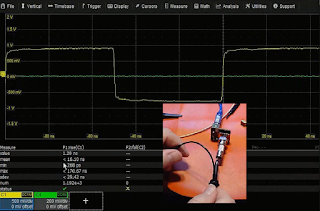 |
| Fig 1. Coaxial
cable has little effect on signal rise time, but that's not true for every connection method. |
Using the same 40 ps fast edge signal we used for the risetime measurements in the last post, we’ll compare connections made using coaxial cable and a 10x passive probe, with and without different accessories.
Coaxial Cable
Using a matched coaxial cable has a very minor effect on the
signal rise time. With a 1-meter, 50 Ohm coaxial cable, rise time increases only
slightly from 470 ps to about 500 ps (Fig 1).
 |
| Fig 2. Adding
a mini-grabber to a coaxial cable significantly increases rise time and can distort the signal. |
10x Passive Probe
 |
| Fig 3. Inductance
caused by ground leads can cause overshoot and ringing. |
Many probes come with a number of adapters to reduce ground lead inductance, such as coaxial adapters and spring clips. Using a coaxial adapter with the passive probe replaces the ground lead, and when mated with a BNC connector results in a low inductance connection, which improves measurement fidelity.
 |
Fig 4. Using a coaxial adapter with a passive probe minimizes ground lead inductance. |
 |
| Fig 5. The ground
spring reduces the length of the ground connection and the lead inductance. It also reduces antenna pickup. |
Watch Dr. Eric Bogatin demonstrate this concept in the on-demand webinar, SI/PI Measurements on a Budget.
Also see:
Four Measurement Best Practices
Situational Awareness: Testing Oscilloscope Outer Limits
No comments:
Post a Comment